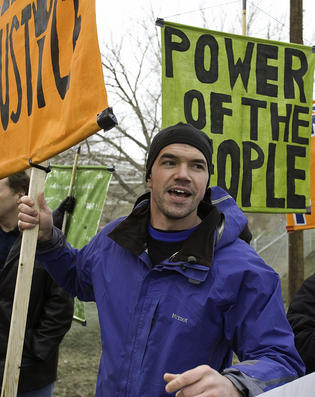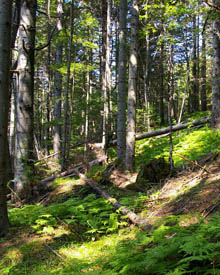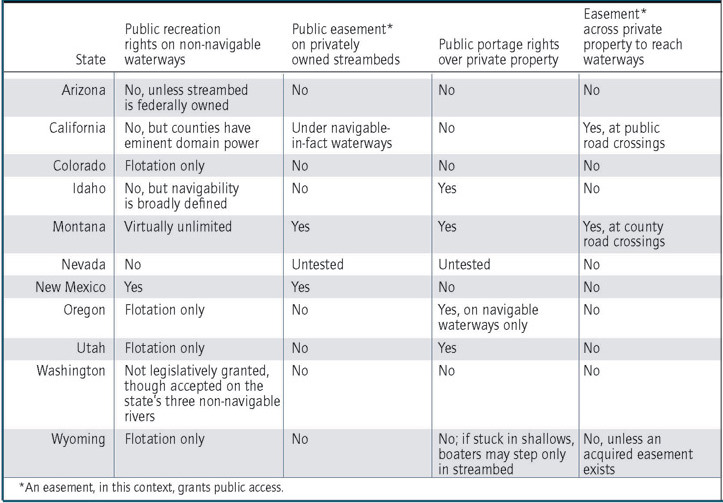Why are ranchers and mineral companies allowed to bid on federal land leases, but the public cannot? If environmentalists could lease the land they want to conserve, taxpayers might see a higher return and also avoid some bitter disputes.
Author Archives: admin
What If DeChristopher Could Bid?
Cross-posted at Grist. Photo: 350.Before By now you’ve probably heard the story of Tim DeChristopher, the 27-year-old activist who single-handedly shut down an entire Bureau of Land Management auction back in December 2008. DeChristopher, then a student at the University of Utah, snuck into the oil and gas leasing sale, posed as a bidder, andContinue reading “What If DeChristopher Could Bid?”
Forests and Wildfires: A Carbon Source or Sink?
Forests are a valuable part of the global carbon cycle. They hold the largest stock of terrestrial carbon on earth, mostly stored in living trees. Forests absorb, or sequester, carbon during photosynthesis. More carbon is absorbed in younger trees during faster growth phases. Carbon is emitted in decomposition and when wood is burned. Net carbonContinue reading “Forests and Wildfires: A Carbon Source or Sink?”
Ownership Encourages Stewardship: A Look at Stream Access in the West
High Country News reports on stream access laws in the West and provides the updated chart below, which originally appeared in PERC Reports: Recent attempts to limit Montana’s Stream Access Law, the most permissive in the West, have reignited debates over the impact of access laws. The Michell Slough in Montana’s Bitterroot Valley, once considered an irrigation ditch, has featuredContinue reading “Ownership Encourages Stewardship: A Look at Stream Access in the West”
Lessons Learned in Rights-Based Fisheries Management
PERC’s latest workshop begins today on the lessons learned in rights-based fisheries management. Fisheries experts from around the world have arrived to discuss the most recent research being conducted on rights-based approaches to fisheries management — approaches that have proven to halt, or even reverse, the global trends toward overfishing. For the past few decades, PERC’sContinue reading “Lessons Learned in Rights-Based Fisheries Management”
Don’t Buy ‘More People, More Problems’
Mary Ellen Harte and Anne Ehrlich write,“Unsustainable population levels are depleting resources and denying a decent future to our descendants. We must stop the denial.” We are in denial for a reason. For more than 40 years, climaxing around the first Earth Day, the public has been bombarded with apocalyptic tales of disaster regarding populationContinue reading “Don’t Buy ‘More People, More Problems’”
The promise and Problems of Free Market Environmentalism
Free market environmentalism works well for problems pertaining to natural resource allocation, where well-defined property rights solve the problem of excludability.
Q&A with PERC Enviropreneur Dave Wager on Tree Ring Pens
Q&A and video with PERC Enviropreneur Dave Wager on Tree Ring Pens.
Managing for Wildfire
Are federal land management policies exacerbating wildfires? That is a question rightfully being asked by many Arizona politicians and citizens. By July 1, the state had already seen more than 1,000 fires ravaging over 750,000 acres and the loss of at least 100 structures and 40 homes. This year’s rabid wildfires are in part theContinue reading “Managing for Wildfire”
Q&A with Claire Priest on the Origins of American Property Law

Claire visited PERC as a 2011 Lone Mountain Fellow. We thank her for taking the time to answer our questions. For more of PERC’s Q&A series, visit the archived Q&As here.
Q: Your book project provides a new account of the evolution of property law in early America. What will your book emphasize that other historical scholarship has not focused on?
The role of property in historical accounts has generally related to the ideological revolution taking place during the Founding Era of the United States. The political leaders of the Founding Era believed that dismantling vestiges of aristocracy was crucial to the success of a republican society. They emphasized the need to make property in land dynamic and available in the market, rather than having the legal system protect stable landholding by an aristocracy. Historians have traced the path of republican views from the colonial era forward, to demonstrate the republican underpinnings of the Revolution.
I focus on a wider range of issues. In my view, the central force shaping property law in early America from the earliest years of colonization was the desire to use land and other assets, such as slaves, as collateral for the purpose of obtaining credit. The colonists brought English law and legal traditions with them but reformed those laws to adapt to the new conditions present in the colonies. Reforming the law to encourage credit markets was a major trend. One reform was to legally define land as a “chattel” commodity when creditors’ interests were involved. This allowed more stream-lined processes to be used when creditors tried to seize debtors’ land in the case of default on a debt. In addition, in contrast to England, in the American colonies, creditors were given legal priority to land over the landowner’s heirs during inheritance proceedings. Colonial courts and land recording offices also innovated by making title interests and the claims against those interests publicly accessible. Credit markets in the American colonies were robust.
Unfortunately, strong credit markets encouraged the expansion of slavery, a form of labor that depended on upfront payments of money. Slaves were often purchased on credit and themselves became a primary form of collateral in credit agreements. I believe this story is very important to our history.
Q: How did the emergence of these laws and institutions relating to property in early America affect the way we view property rights and law in modern America?
A: We take it for granted in America that credit is easy to come by and that we will receive financing for purchase of assets from cars to homes. Filing a financing statement to use chattel goods as security is inexpensive and easy. In many countries, however, the institutions and courts are costly and time-consuming to navigate. I have been interested in how history might explain the vastly different legal environments around the world today.
I also think the history is closely related to the insights of PERC: being able to use property rights to achieve conservation outcomes requires a system that is flexible. To give a prominent example, markets in carbon credits are now well-established in our country. Where did the flexibility in the system come from that allows trading in a good like carbon emissions?







